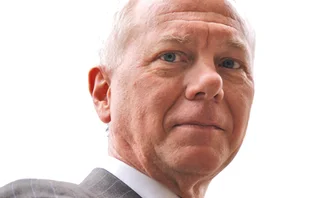
The Latin quarter
A plan unveiled by Argentina’s economy minister Roberto Lavagna for the country to slash the value of its debt by three-quarters has been given a lukewarm reception by the financial markets. Josh Goodman assesses the impact of the proposals

It had all the drama investors have come to expect from the ongoing saga surrounding the largest default in history. To the accompaniment of a loud din of mobile phones, some 200 bankers, analysts and a cadre of financial VIPs solemnly filed into a Dubai conference room to await the big announcement. At 4 pm local time on September 22, 2003, the presentation got rolling. On two screens, one in English and another in Spanish, being broadcast live back to Buenos Aires, Argentina economy minister Roberto Lavagna unveiled his government’s much-anticipated plan to reduce by 75% the nominal stock of some $94.3 billion in defaulted debt.
“It was like watching a nightmare come true right before my eyes,” says one attendee, Peter Allen, a special advisor to the Argentina Bondholders Committee, which represents institutional investors holding $7.5 billion in defaulted bonds. “For the past 20 years I’ve always feared the day would come when a sovereign debtor decided to completely stiff its creditors. But I never imagined I’d really see it.”
The line drawn in the sand at Dubai, though, was just the beginning. A far trickier showdown with creditors awaits Argentina in the coming months, this time behind the scenes and away from the controlled setting of a desert oasis. Nobody expects it to be pretty. Unlike any other sovereign default before it, experienced institutional investors hold barely half of the mostly bonded debt being restructured. The rest belongs to 500,000 retail investors spread across the globe, from workers in Japan to ageing grandmothers in Italy, in each of the eight legal jurisdictions where 152 separate bond issues were placed by Argentina.
The task of co-ordinating with such a diverse range of creditors in time to meet an early 2004 promise to launch the offer requires an almost superhuman effort from Argentina’s negotiating team. “There are so many wild cards still that even under the best scenario it’s unlikely they could get the exchange done before the end of 2004,” says Christian Stracke, head of emerging market research for independent credit research provider CreditSights.
To make matters worse, creditors are convinced that Lavagna and finance secretary Guillermo Nielsen are just going through the motions. Given Argentina’s checkered financial past and the fact that the sovereign took almost two years to submit a first offer after its default, expectations were already low.
A radical haircut
The size of the debt forgiveness and terms of the proposal, however, exceed all precedent in Argentina and compare only to the sort of debt relief conceded to much poorer countries in sub-Saharan Africa. The net present-value haircut that Argentina won during its Brady restructuring a decade ago, negotiations which Allen led on behalf of creditors, still amounted to a 60 to 70 cent repayment on the dollar.
By contrast, Argentina’s diktat of a 75% writedown goes against common practice in other restructurings inasmuch as it excludes recognition of the $11 billion in past-due interest accumulated (and still growing) since December 2001 – probably the biggest surprise to investors. If the accrued interest were calculated, the net present-value haircut would surpass 82%, say analysts.
“It’s like my four-year-old saying he wants to stay up past midnight – it’s not even discussable,” says Abby McKenna, portfolio manager for Morgan Stanley. “If the proposal were to prosper, it would totally rewrite the entire spectrum of debt forgiveness, private and public, as we know it.”
Indeed, judging by the market reaction since Dubai, investors would appear to be calling Lavagna’s bluff. Although bond prices initially dropped, they have since stabilized above the reduced levels contemplated by the proposal, at around 27 cents, indicating that creditors believe Argentina will come to its senses once the real haggling begins.
But that may just be wishful thinking. Emboldened by having wrested from the International Monetary Fund what many are calling a ‘sweetheart’ deal, Lavagna has vigorously defended the proposal as a realistic reflection of Argentina’s ability to pay. Investors, however, counter that with an economy growing at 7% this year Argentina can, and should, do more.
At the heart of the dispute is the 3% primary fiscal surplus target for 2004, or $4.2 billion, which Argentina set with the IMF in exchange for rolling over $14.6 billion in loans. Creditors correctly point out that this is well below the 6–7% target range of other recent defaulters and even falls short of the 4.25% target set by Brazil, which has so far avoided default. Partly reflecting its own displeasure with Argentina’s savings effort, the IMF left in blank fiscal targets for 2005 and 2006.
“Calculating a country’s debt servicing capacity is an art, not a science,” says Juan Luis Bour, director of Fundación de Investigaciones Económicas Latinoamericanas (FIEL), a Buenos Aires-based economic think-tank. “It basically comes down to how much political will there is to pay. In Argentina’s case, it’s clear that bondholders are being relegated to the lowest priority.”
Lavagna, whose reputation as a tough negotiator and straight talker is well known, says creditors’ questioning of the basic premise of Argentina’s proposal is hypocritical and unfair. In an October 10 interview with Credit, the 61-year-old economist had this to say to his critics: “Argentina had an average fiscal deficit of 2.1% last decade and nobody said anything. And now, in the middle of the worst crisis in a decade, we’re committing ourselves to an unprecedented 3% surplus. For those who say it’s not enough to pay the debt, I’d respond [by saying] they should have looked at the situation with the same objectivity before.”
Endebted
Flawed or not, bondholders concede the proposal is based on some pretty lofty assumptions about Argentina’s source of financing in the coming years. Even if Lavagna gets his way, repaying the debt won’t be easy. Hanging over the entire process like a Damoclean sword is another $84.5 billion in senior debt, 47.3% of the total stock, which Argentina has excluded from the restructuring. Around $30 billion is owed to multilaterals and is unlikely to suffer any modifications, despite the anger-fed fantasies of bondholders who bought into Argentina based on the IMF’s blind endorsement of President Carlos Menem’s free-market policies last decade.
The rest are IOUs Argentina has issued since default, the bulk to bailout banks left insolvent by the government’s devaluation and forced ‘pesofication’ of dollar deposits at an exchange rate 40% higher than the one used to convert assets. Under the current plan the government optimistically estimates that up to 75% of that low interest debt will be rolled over when it starts maturing in 2005.
Assuming Argentina grows at the projected 3.5% rate over the next 15 years – a feat that flies in the face of the country’s boom-bust cycle of the past four decades – the government will still be stuck servicing a significant debt load equivalent to 80% of GDP versus the current 150%. Not surprisingly, many analysts predict that the new debt will also eventually have to be restructured, something Lavagna denies. “Investors have a short memory – they’ll make a distinction between what’s stock and what’s flow,” says Lavagna.
Maybe so. Argentina has a long tradition of forcing local institutions to finance chronic public deficits. But the same bully-boy tactics are not likely to work with foreign investors.
Indeed, by acting so brazenly analysts say Argentina runs the risk of foreign bondholders walking out on the negotiation process altogether and isolating the country even more than it already is. Already a handful of lawsuits have been brought against Argentina with some success in foreign courts. In the most important case a New York judge ordered Argentina to pay US investor Kenneth Dart $710 million, although the judgment was suspended until late October while Argentina prepared its restructuring offer. After a two-year legal battle back in 1994 Dart collected in a similar case against Brazil during that country’s Brady bond restructuring.
Although speculative investors like Dart probably never intended to sit down with the government Dart’s favorable ruling underscores the legal risks and real-life headaches the government faces if it treats creditors with disregard. In October newspapers reported that President Néstor Kirchner had canceled a state visit to Germany because of the fear that Tango 01, the presidential plane bought by Menem for $66 million and a symbol of the spendthrift 1990s, could be confiscated.
ABC and other creditor groups representing big institutional investors say they are reluctant to sue, for now, because of the hefty fees, long wait and collecting difficulties it entails. Even so they welcome the pressure brought to bear from Dart and other individuals pursuing legal action. “The sheer number of individual bondholders and the magnitude of the haircut being proposed make the risk of litigation for Argentina greater than any sovereign default we’ve seen,” says Mark Richards, a lawyer at the Los Angeles office of White & Case specializing in sovereign restructurings.
The true incentive for Argentina to up its offer will come from the economy, not lawyers. After collapsing 19.5% in the last four years – 10.9% in 2002 alone – the economy’s robust 7% rebound so far this year has impressed both Argentina’s friends and foes. But pent-up demand and one-time windfalls like an import substitution manufacturing boom produced by the devaluation are responsible for the bulk of the growth. Meanwhile, long-term investment and credit, two items needed for the recovery to continue, have lagged as the government has failed to articulate a coherent economic program. For example foreign direct investment, a crucial factor in Russia and Brazil’s post-devaluation recovery, was just $1 billion last year, less than a tenth of the annual average last decade.
“Even if the government doesn’t need access to international capital markets, the private sector does,” says Adam Lerrick, head of the Argentine Bond Restructuring Agency, which negotiates on behalf of European investors with $1.2 billion in bonds. “The real pressure on Argentina to complete a restructuring will come when the economy starts to slow.”
| Digging out of debt: the road ahead Getting out of the biggest sovereign debt default is big business. In addition to the multi-million dollar bank commissions Argentina will pay once a swap offer is launched, there are huge legal fees, travel expenses and long-distance phone bills to be paid as authorities attempt to get a grip on one of the most unwieldy debts ever seen. A snapshot of what Argentina owes and to whom shows why. According to the restructuring guidelines presented at the International Monetary Fund annual meeting in Dubai, Argentina will owe an estimated $178 billion in December 2003. Of the $94.3 billion being restructured – 52.7% of the total debt – just over half is denominated in US dollars, 33% in euros, 3% in yen and the rest in pesos and three other currencies. When Argentina’s credit rating was near investment grade last decade, investment banks sold Argentine debt all over the globe. As a result, only 38.4% of an estimated 500,000 bondholders reside in Argentina. The rest consist of investors in Italy (15.6%), Switzerland (10.3%), USA (9.1%), Germany (5.1%), Japan (3.1%), UK (1.1%) and others. Although the haggling over Argentina’s proposed haircut and other financial terms has just begun, the structure of an eventual deal is largely in place. Argentina plans to fold 152 old bonds issued in seven currencies into three new instruments, in euros, dollars, yen and indexed Argentine pesos. Although interest rates and maturities are still being discussed, investors will be able to choose among the following three options: first, a discount bond, with a significant reduction in principal but carrying a higher investment rate and shorter maturities; second, a par bond, geared toward retail investors, containing almost no writedown but low interest rates and extended maturities; third, and most innovative, a bond whose interest rate will be indexed to Argentina’s economic performance in the coming years. Leading the exchange offer will be a syndicate of 12 international investment banks invited by the government. They are JPMorgan, Morgan Stanley, Citigroup, Deutsche Bank, UBS Warburg, Goldman Sachs, ABN Amro, Lehman Brothers, BNP Paribas, Nomura, Dresdner Kleinwort Wasserstein and Barclays Capital. Argentine banks Banco Galicia, BBVA-Banco Frances and state-run Banco Nación were selected to organize the domestic tranche of the exchange. |
| In the spotlight
Not since Domingo Cavallo, the whiz-kid creator of the fixed currency regime that dominated the economy for a decade, have Argentines deposited so much trust in an economy minister as the incumbent, Roberto Lavagna. The proof is in his longevity: 18 months, longer than any of his four predecessors (including a revived Cavallo) who between them have held the job since 1999. During his time in office, Lavagna has won the confidence of Argentines by putting their devastated economy back on its feet while simultaneously rolling over $14.6 billion in debt through delicate negotiations with the IMF. Emboldened by his recent successes, a swashbuckling Lavagna is now preparing to take on the 500,000 holders of Argentina’s defaulted debt. “We knew there would be a lot of long faces in various languages,” Lavagna said in an interview with Credit about the government’s presentation of its restructuring plan. “But Argentina’s not going to reach an agreement with creditors at any cost just so we can return to the international capital markets and begin the whole debt cycle again. If we return in three or four years, that’ll be fine.” For creditors left holding a $95 billion unpaid bill, Lavagna’s straight-talking style is hardly inspiring. But even Lavagna’s many foes admit he is the best negotiator they are likely to get with the populist-leaning Kirchner government. An academic with economic degrees from the University of Buenos Aires and University of Brussels, Lavagna got an early taste for politics when he was the official charged with fixing prices during the failed import-substitution policies of the 1970s. As his skeptics see it, his penchant for heavy government intervention has not softened much in the ensuing decades. His 2004 budget proposal, which contains a 12% increase in nominal expenditures, is full of juicy subsidies for deficit-running sectors like the airline industry and railroads. Lavagna defends those policies with now characteristic zeal. “Had we allowed these companies to fail, we would have been stuck with more unemployment and an even greater fiscal cost in the form of welfare checks,” he says. ¨Unfortunately there are still people who haven’t realized that managing an economy consists of much more than accommodating bankers and businessmen.” Even if he is not the orthodox free-marketer Wall Street would prefer, Lavagna is a pragmatist and someone who, so far at least, delivers on his promises. He is also an astute negotiator, something picked up perhaps during his recent tour of duty as Argentina’s ambassador to the EU. “The only thing shorter than investors’ patience is their memory,” he says. “Look at Russia – four years after default it’s now investment grade.” |
Only users who have a paid subscription or are part of a corporate subscription are able to print or copy content.
To access these options, along with all other subscription benefits, please contact info@risk.net or view our subscription options here: http://subscriptions.risk.net/subscribe
You are currently unable to print this content. Please contact info@risk.net to find out more.
You are currently unable to copy this content. Please contact info@risk.net to find out more.
Copyright Infopro Digital Limited. All rights reserved.
As outlined in our terms and conditions, https://www.infopro-digital.com/terms-and-conditions/subscriptions/ (point 2.4), printing is limited to a single copy.
If you would like to purchase additional rights please email info@risk.net
Copyright Infopro Digital Limited. All rights reserved.
You may share this content using our article tools. As outlined in our terms and conditions, https://www.infopro-digital.com/terms-and-conditions/subscriptions/ (clause 2.4), an Authorised User may only make one copy of the materials for their own personal use. You must also comply with the restrictions in clause 2.5.
If you would like to purchase additional rights please email info@risk.net
More on Economics
Global investment outlook: 2026 and beyond
Broadening, steepening and weakening: Franklin Templeton’s top investment ideas for 2026 and beyond
Webinar – Nowcasting the US economy
Join CME Group Chief Economist, Blu Putnam, as he shares insights using alternative data and nowcasting to monitor developments in the US economy.
Fed Funds Futures in a Post-ZIRP World
As the FOMC returns to more active management of its key target rate, Federal Funds futures have experienced dramatic growth.
Challenging economic pessimism: an optimistic note
A contrarian, upbeat view of the long-term economic outlook
Economists, like hedge fund traders, need open minds
Economists, risk managers and traders must learn the lessons of crisis, says Kaminski
Fed wrong not to start QE tapering, says UBS economist
The surprise decision by the Federal Reserve last month not to scale back its quantitative easing programme will create more volatility, says economist







